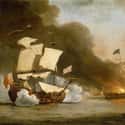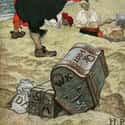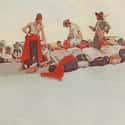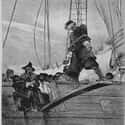-
(#1) Insurance Payments For Injured Pirates Came Out Of Everyone's Loot
Although experts debate just how democratic pirate groups were, they were surprisingly progressive when it came to the spoils of their enterprises: they created a sort of insurance fund for injured pirates. This meant that were a member of a group to become injured, they were still able to reap the benefits of a successful campaign.
Individual groups' charter articles identified the amount of loot to be paid to injured pirates. So, spoils were gathered together in the aftermath of an attack; injured pirates all received the amount specified in their charter; and the rest of the group divided the remainder among themselves.
-
(#2) Pirate Earrings Also Served Another Practical Purpose; They Protected Hearing
Pirate ships were outfitted with numerous cannons. Blackbeard’s Queen Anne’s Revenge, had a whopping forty. Those cannons were vital during combat when a pirate ship might need to sink an enemy to prevent capture. Cannonballs were accompanied by a loud blast, though, and were known to deafen.
The crafty sea criminals would hang wads of wax from their earrings to prevent this sound damage. They popped the waxy contraptions into their ears like a makeshift earplug when firing cannons.
-
(#3) Pirates Practiced Gay Marriage As Early As The 1600s
Pirates spent long periods of time on ships surrounded by other men so it’s no surprise that some shared intimate relationships. Other pirates formalized same-sex relationships through a practice called matelotage, a French word that may be at the root of the pirate greeting "Ahoy mate."
In pirate society, two men could join into matelotage and share all their plunder, even receiving death benefits if one died before the other. Pirate mates would live together, exchange gold rings, and sometimes even share female prostitutes.
-
(#4) Pirate Earrings Served As An Insurance Policy To Finance Their Burials
Pirates spent their lives on the high seas but they didn't want to spend death at the bottom of an ocean (or Davy Jones’s Locker). The infamous piercings that pirates wore in their ears were actually insurance to make sure that they'd be given a proper burial. Whether gold or silver, the precious metal could be melted down and sold to pay for a casket and other funeral necessities even if a pirate's dead body washed ashore.
Some pirates went so far as to engrave the name of their home port on the inside of the earrings so that their bodies could be sent home for a proper burial.
-
(#5) No One Ever Wanted To See The Bloody Red Pirate Flag
The Jolly Roger flag that flew from pirate masts was terrifying but the most dreaded sea flag was red. A ship hoisting a red flag warned its enemies that no mercy would be given to a captured ship; everyone on board would be killed immediately.
The red flag was sometimes called the “Bloody Red” and if it replaced a skull and crossbones flag, the pirates under siege might sometimes jump ship.
-
(#6) No, Pirates Weren’t All Missing An Eye - The Patches Helped Them With Night Vision
Some pirates were definitely missing eyeballs; their ships were dangerous places, after all. But other pirates wore eye patches for different reasons. By wearing an eye patch, the sea buccaneers could always keep one eye adjusted to night vision. Pirates spent a lot of time going from the bright light above deck to the darkness below deck, especially when they were raiding ships or defending their own.
If he lifted his patch before going below deck, a pirate could instantly see even if there was only a little light.
-
(#7) There Was A Secret To Maintaining Blackbeard's Terrifying Facial Hair - Using Hemp Kept It In Frightening Shape
Born Edward Teach, Blackbeard was arguably the most terrifying pirate in the world and he built his reputation on hemp. In the early eighteenth century, Blackbeard captained the Queen Anne’s Revenge but before capturing that ship or any other he'd weave hemp into his long dark beard and under his captain hat. Once he lit the hemp on fire, smoke billowed out from his face and made his opponents fear for their lives.
In addition to his burning beard, Blackbeard also wore a crimson coat and carried at least two swords, pistols, and knives at all times.
-
(#8) Pirates Could Be Upstanding Members Of The Land-Side Community
The prevailing image of pirates has them as swashbucking, tradition-bucking, lawless individuals who just so happen to sail in groups on the open ocean. In this way, they're anathema to landlubbers and vice versa. But – while they were prone to violence and did exist mostly on the seas – pirates could still participate in familial and communal activities on land.
Scholar Daphne Palmer Geanacopoulos found record of prominent pirates, like Captain William Kidd, contributing to social organizations on land as "prominent members of Colonial society." Captain Kidd, for example, not holy helped found Trinity Episcopal Church, but he also commissioned a pew in the church specifically for his family.
-
(#9) Most Pirates Enjoyed A Good Hostage Situation, Some Even Managed To Nab Julius Caesar
Pirates haunted the seas since humans first invented boats and they’ve captured their share of famous hostages. In 75 BCE, pirates captured Julius Caesar but when they only asked for a ransom of 20 talents, Caesar laughed in their faces and told them he was worth at least 50.
While he was held captive, Caesar serenaded the pirates with poetry. Once his ransom was paid, though, Caesar had the pirates crucified as punishment.
-
(#10) Pirates Doubled As Mixologists - They Created A Drink That Prevented Certain Diseases
Credit for the invention of grog goes to sailors in the British Navy, who first started making the drink some time in the 1600s. To avoid drinking slimy water contaminated with algae and microbes, the sailors mixed rum into their water. In 1731, the British Navy gave each sailor half a pint of rum per day; that was equivalent to over five shots of alcohol.
Pirates borrowed the recipe for grog and made it legendary by adding lemon juice (it helped prevent scurvy) and sugar (it tasted good). Their's was a drink that packed a punch.
-
(#11) Pirates Had All Kinds of Superstitions About Their Earrings
The earring might be the most famous piece of pirate jewelry; they were certainly very practical. The sea buccaneers were quite superstitious about the hoops, though, and there were many myths about the earrings' otherworldly abilities. One tale claimed that they could prevent sea sickness while another suggested that the precious metals could cure bad eyesight.
Many pirates believed that a gold earring could prevent a man from drowning but that myth was disproved a number of times.
-
(#12) Most Pirates Didn’t Bury Their Treasure
Even though it’s easy to picture a pirate burying treasure on a tropical island, only one pirate, William Kidd, was ever recorded as having buried treasure. Kidd deposited his loot off the coast of Long Island but the scheme backfired when an ally dug up the trove and used it as proof to convict Kidd of piracy.
-
(#13) Pirates Mostly Stole Booze and Weapons, Not The Kind Of 'Treasure' Shown In Movies
There’s a good reason why most pirates didn't bury their treasure; most of their booty wasn't gold and jewels. Pirates typically stole food, alcohol, and weapons, in addition to lumber, cloth, and animal hides - essentially, whatever ships might be carrying across the Atlantic. Those goods weren't worth much in the ground so pirates used them immediately or sold them.
Only one fully authenticated Golden Age pirate shipwreck has ever been discovered. The treasure from the Whydah Gally (pictured) was discovered off the coast of Cape Cod in 1984, 260 years after it went missing.
-
(#14) The Most Famous Pirates Probably Weren't The Most Successful Pirates
In a strange but sensible irony, the pirates whose names have made their way through the decades of history to the present day probably weren't the most successful pirates. According to museum curator David Moore, the pirates whose names we know were the ones who got caught.
In Moore's line of thinking: "The reason many [pirates] became famous was because they were captured and tried before an Admiralty court. Many of these court proceedings were published, and these pirates' exploits became legendary. But it's the ones who did not get caught who were the most successful in my book."
-
(#15) Ladies Liked To Pirate Too
Women also took to the seas to make their fortunes. One pair, Anne Bonny and Mary Read, sailed together on the pirate ship Revenge in 1720. Anne Bonny even served as first mate. Some, like Mary Read, chose to dress as men to hide their identities.
Unfortunately, their ship was captured and both women ended up in jail. Bonny blamed their captain, Calico Jack, and reportedly cursed him in prison, saying, “Sorry to see you there, but if you'd fought like a man, you would not have been hang'd like a Dog."
-
(#16) The Jolly Roger Is The Best Known Pirate Flag But It Has Many Variations
The Jolly Roger black flag with a skull and crossbones might be the best known pirate insignia but there are multiple versions of that banner. The first mention of the Jolly Roger came from the 1724 book, A General History of the Pyrates, by Charles Johnson.
Blackbeard’s flag, for example, featured a skeleton toasting the devil while spearing a bleeding heart. Others had red skeletons, hourglasses, or even men standing on skulls.
-
(#17) The Plank Was Mostly A Myth, And Their Way Of Actually Killing People Was A Lot Worse
While there is some evidence pirates did use walking the plank as a form of psychological torture, there is not enough evidence to prove it was a widespread practice. It became popular thanks to the rise of pirates in entertainment in the 19th Century. There were plenty of other ways pirates killed people, and some of it involved forms of torture. But for the most part, anyone they wanted to execute was killed quickly and swiftly.
But the most common form of death-by-torture involved something much worse than a plank. It was called keelhauling, and it involved throwing the victim into the water underneath the boat. They would hoist him up on one side, passing him under the ship's keel, and then place a large weight on his legs to make sure he stayed underwater. As if that wasn't enough, the perpetrator then endured being pulled by the ship's weight and drowned. If they were lucky, the blow from being thrust against the ship's bottom would be enough to kill them.
-
(#18) Marooning People Was A Real Thing
Pirates did actually maroon people on isolated land masses when they did something wrong. It was considered one of the worst ways to die, because it was slow. Typically those marooned were disgraced pirates who violated the rules of a ship. He would be placed on an isolated sandbar with just the clothes on his back, a small portion of water, and a weapon.
Pirates who were marooned had the option to kill themselves with their weapon, but it was widely considered cowardly. Some men actually managed to survive being marooned if they were rescued by a different pirate crew, but that was very rare.
New Random Displays Display All By Ranking
About This Tool
Our data comes from Ranker, If you want to participate in the ranking of items displayed on this page, please click here.


















